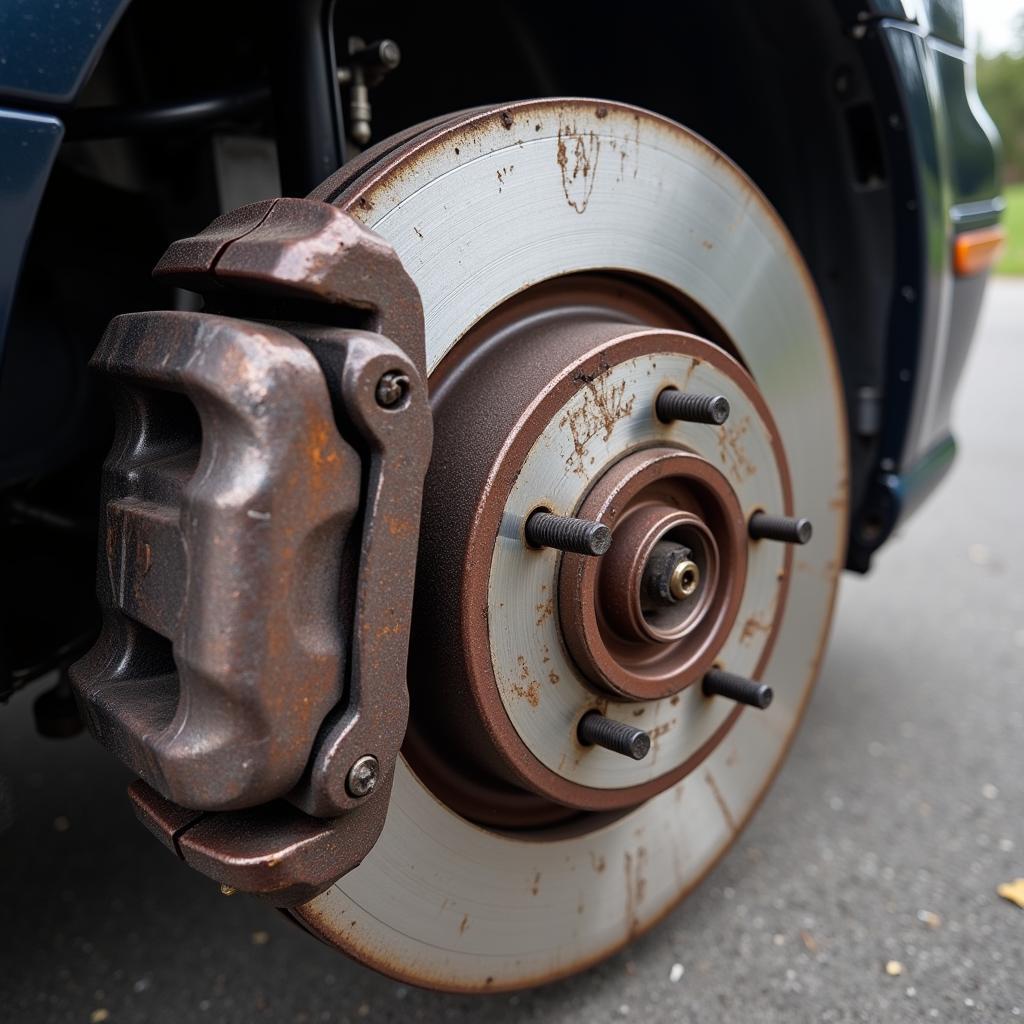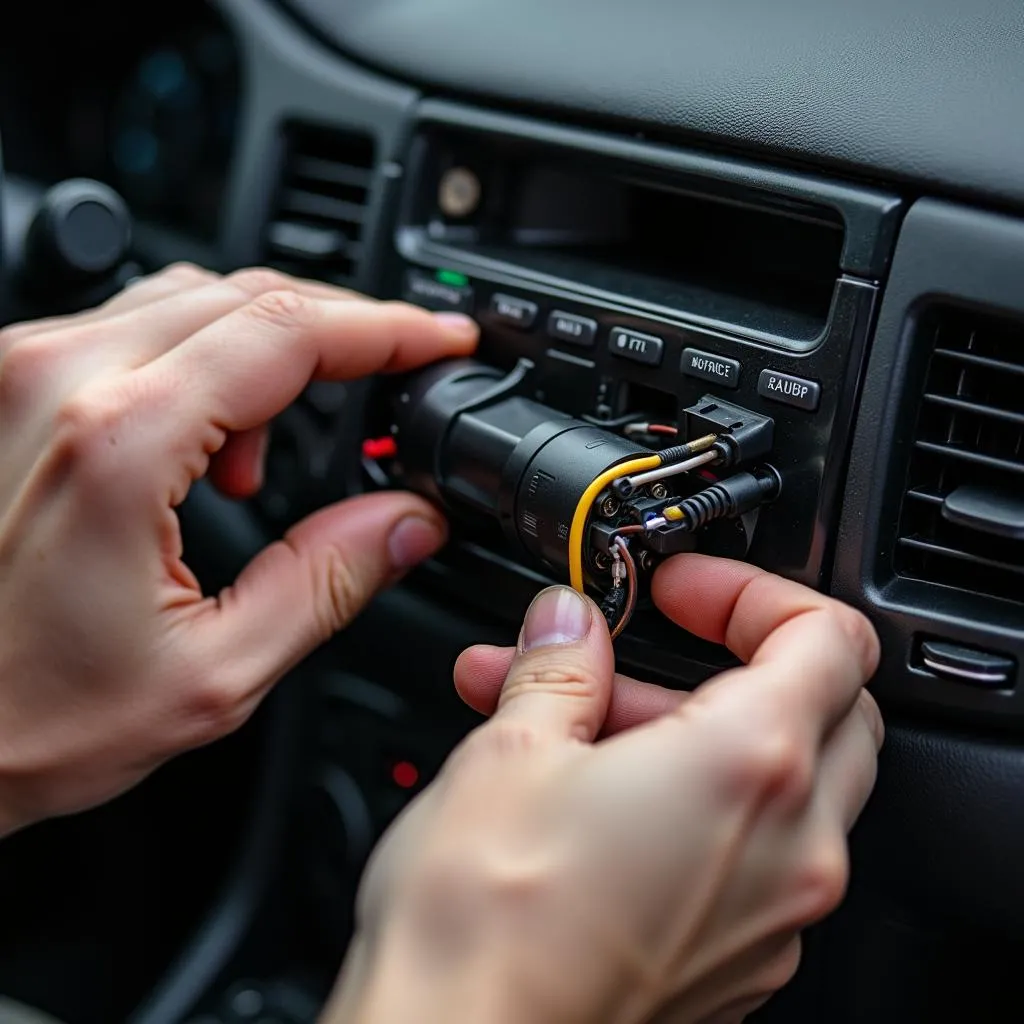The brake pad warning light on your 2006 Jetta is a crucial safety feature that shouldn’t be ignored. When illuminated, it typically signals that your brake pads have worn down to a point where they need replacement. This article will delve into the common reasons behind a 2006 Jetta brake pad warning light, potential troubleshooting steps, and offer guidance on how to address the issue.
Understanding Your Jetta’s Brake Pad Warning System
Volkswagen utilizes a straightforward yet effective system to alert you about brake pad wear. Embedded within the brake pad material itself is a small metal sensor. As your brake pads wear down over time, this sensor eventually makes contact with your brake rotor. This contact completes a circuit, causing the brake pad warning light to illuminate on your dashboard.
Common Causes of a 2006 Jetta Brake Pad Warning Light
While worn brake pads are the most frequent culprit, several other factors can trigger the warning light on your 2006 Jetta:
- Worn Brake Pads: This is the most common cause. Over time, friction from braking wears down the brake pad material.
- Faulty Brake Pad Sensor: Like any electrical component, the sensor itself can malfunction. A break in the sensor wire or a faulty connection can trigger the light prematurely.
- Low Brake Fluid Level: Brake fluid is essential for transmitting force from your brake pedal to the brakes themselves. A leak in the brake lines or a severely low fluid level can also trigger the warning light.
- Issues with the ABS System: While less common, problems with your Jetta’s Anti-lock Braking System (ABS) can sometimes cause the brake pad warning light to turn on. This is often accompanied by an ABS warning light.
 Worn Brake Pads on 2006 Jetta
Worn Brake Pads on 2006 Jetta
Troubleshooting the Brake Pad Warning Light
Before assuming you need new brake pads, it’s wise to perform some basic checks:
-
Check Your Brake Fluid: Locate the brake fluid reservoir under the hood. The reservoir will have a “Min” and “Max” marking. Ensure the fluid level falls within this range. If low, add the correct type of DOT 4 brake fluid specified in your owner’s manual.
-
Inspect Your Brake Pads: If you’re comfortable doing so, you can visually inspect your brake pads. Look through the spaces between the wheel spokes. The outer pad will be visible. You should have at least 1/4 inch of brake pad material remaining.
 Inspecting Brake Pads on a 2006 Volkswagen Jetta
Inspecting Brake Pads on a 2006 Volkswagen Jetta -
Listen for Unusual Noises: Unusual noises, such as screeching or grinding when you apply the brakes, are a strong indication of metal-to-metal contact, usually caused by severely worn brake pads.
“Neglecting your brake pad warning light is incredibly risky. Even if it turns out to be a minor sensor issue, it’s always better to err on the side of caution when it comes to your brakes.” – Mark S., ASE Certified Master Technician
What to Do If the Light Persists
If you’ve checked your brake fluid and the light remains on, or if you notice any unusual sounds or sensations when braking, it’s crucial to have your car inspected by a qualified mechanic immediately.
Driving with severely worn brake pads is extremely dangerous. It significantly reduces your braking effectiveness and increases your stopping distance, putting you and other drivers at risk.
[2006 vw jetta tdi brake pad warning wiring]
How Remote Diagnostics and Software Solutions Can Help
In some cases, the issue might not be the brake pads themselves but a fault within the car’s electrical system or even the software controlling the warning lights. This is where remote diagnostics and software solutions become incredibly valuable.
By using specialized equipment, technicians can remotely connect to your 2006 Jetta’s onboard computer system, often without the need for a physical visit to a repair shop. They can then:
- Read and interpret fault codes: These codes provide specific information about the nature of the problem, helping pinpoint the root cause of the warning light.
- Check sensor data: This data includes readings from the brake pad wear sensors, ABS system, and other relevant components, allowing the technician to assess their functionality and identify any abnormalities.
- Perform software updates: Occasionally, software glitches or outdated software versions can cause issues with warning lights and other systems. Remotely updating your Jetta’s software can often resolve these issues.
The Benefits of Remote Automotive Solutions
Remote diagnostics and software solutions offer several advantages:
- Convenience: You can often have your car diagnosed and even repaired without leaving your home or office.
- Speed: Remote diagnostics can be performed quickly, often providing a diagnosis within minutes.
- Cost-effectiveness: In many cases, remote solutions can save you money compared to traditional repair methods.
[brake pad warning light vw jetta]
Preventing Future Brake Pad Warning Light Issues
Here are some tips to help prevent brake pad warning light issues:
- Regular Brake Inspections: Have your brakes inspected by a qualified mechanic at least once a year or every 10,000-12,000 miles.
- Brake Fluid Flush: Brake fluid should be flushed and replaced every 2-3 years or as recommended in your owner’s manual.
- Driving Habits: Avoid hard braking whenever possible. This puts excessive stress on your brakes and can lead to premature wear.
Conclusion
Addressing a brake pad warning light on your 2006 Jetta is not something to postpone. By understanding the potential causes and taking prompt action, you can ensure your safety and prevent more costly repairs down the road. Remember, a well-maintained car is a safer car!

